With their bright red color, lobster mushrooms are one of the most striking fungi in the woods. They're an edible wild mushroom with a subtle shellfish flavor that's easy to identify with no look alikes. I've been hunting and cooking them for over a decade. In this post I'll teach you everything you need to know about them in the woods, and the kitchen.
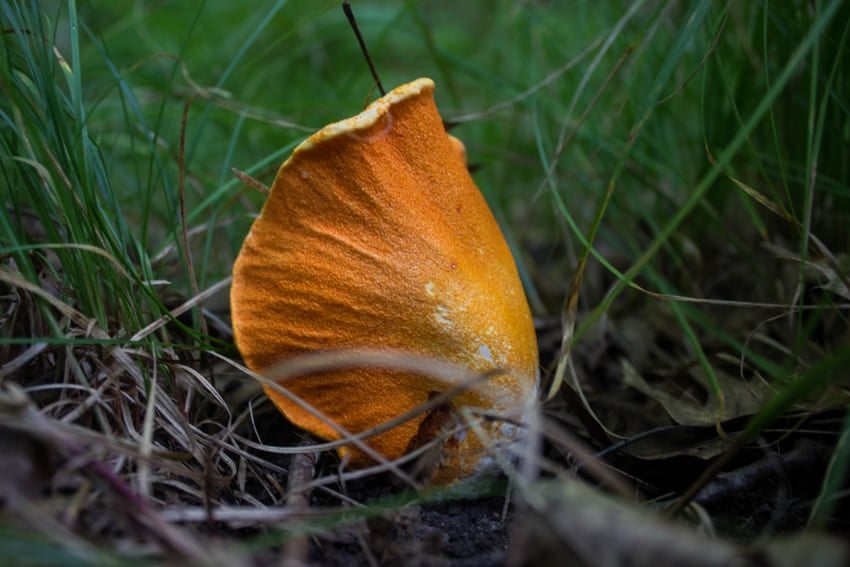
What Are Lobster Mushrooms?
These mushrooms are created when the parasitic fungus Hypomyces lactifluorum infects species of Russula or Lactarius mushrooms, causing them to change shape, color, and flavor.
Long enjoyed in Mexico where they're sold at local farmers markets, in the Michoacan peninsula they're known as "Tromba de Puerco" or pork horn. The name refers to the shape of vase-like mushrooms, and the fact that they're cooked as a meat substitute. They're usually boiled, then fried with tomatoes and onion, eaten with tortillas.
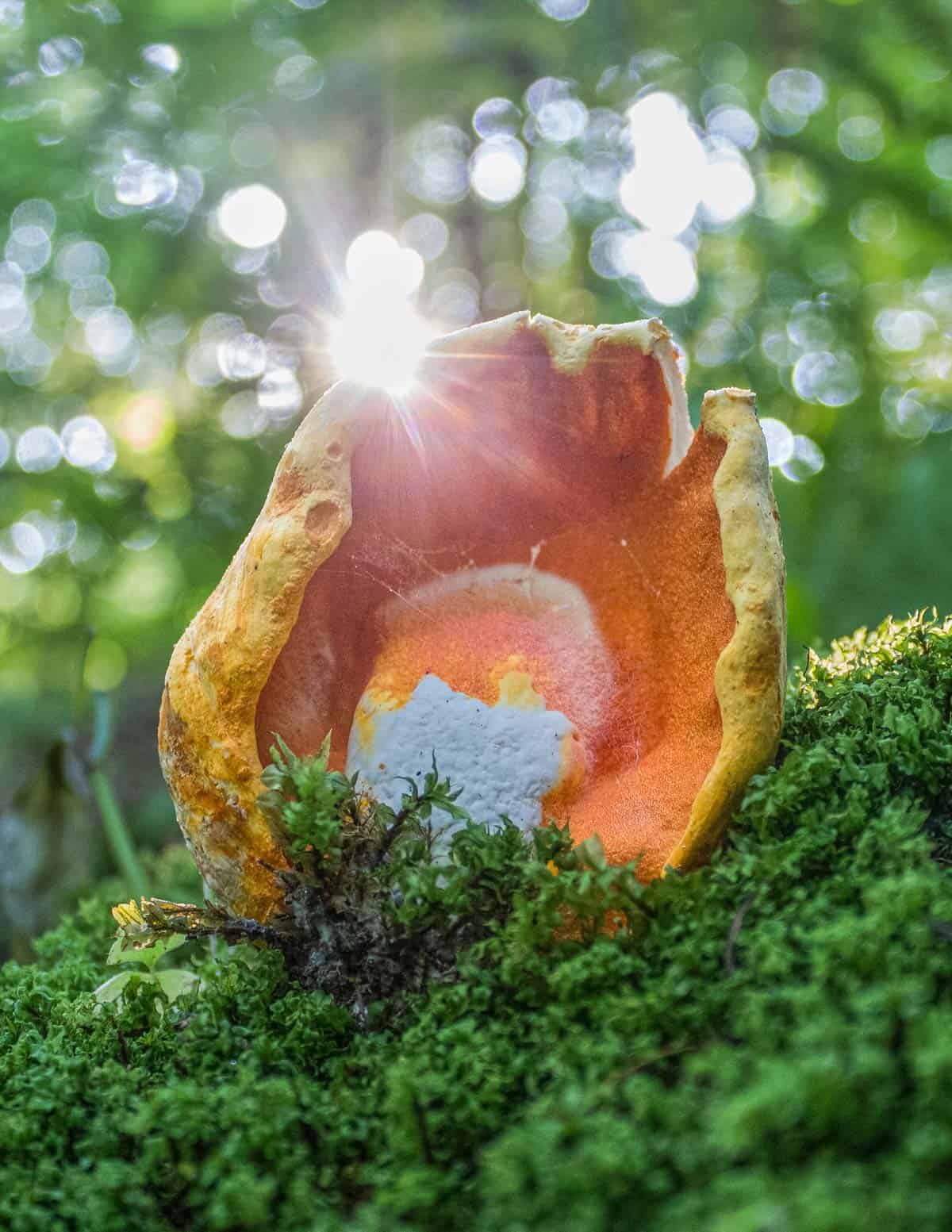
Where to Find Lobster Mushrooms
To find wild lobster mushrooms, you need to find places where Russula or Lactarius mushrooms grow. In the Midwest, lobsters grow in mixed woods. A good trick is to look for large, white mushrooms like Russula brevipes and Lactarius piperatus since they make the best host mushrooms.
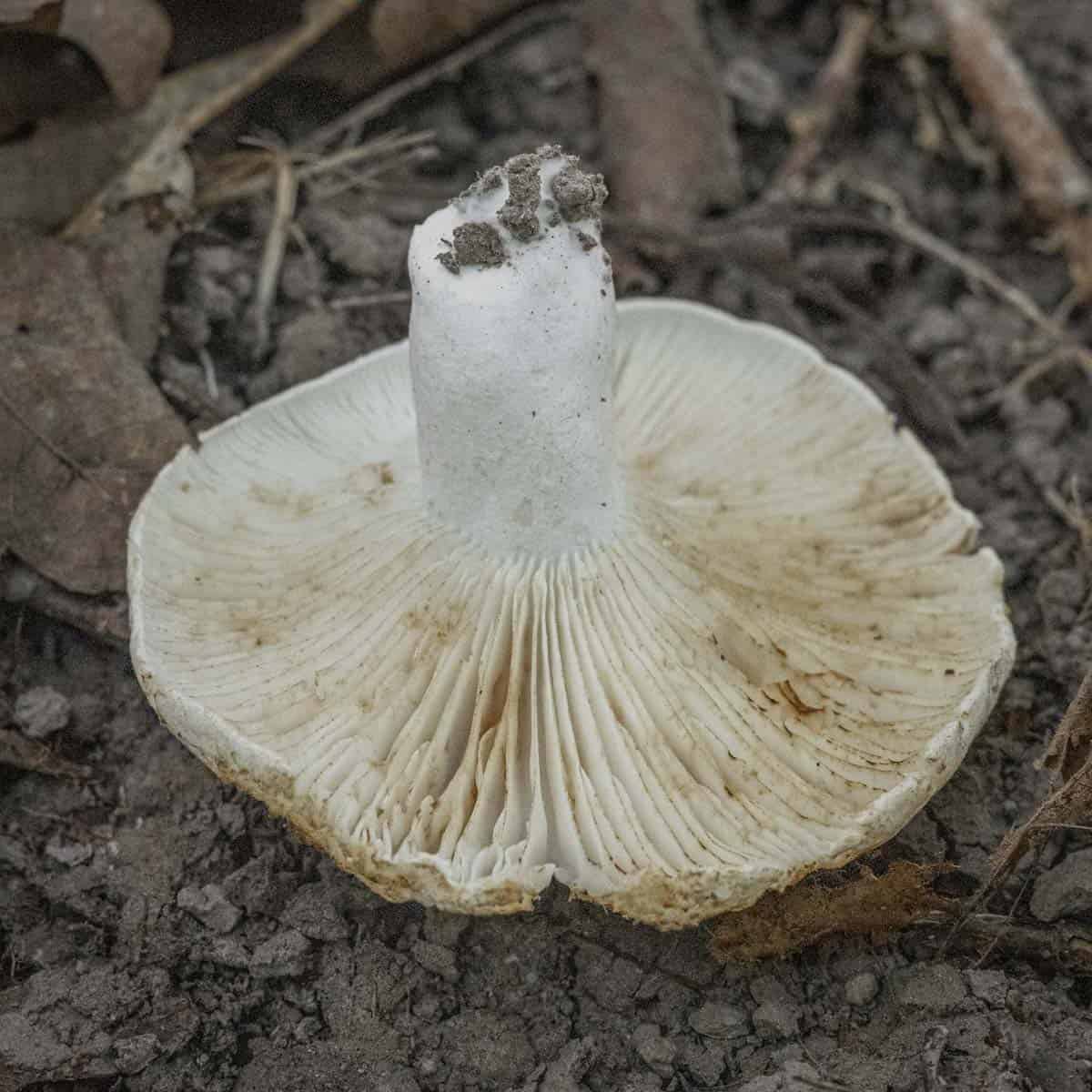
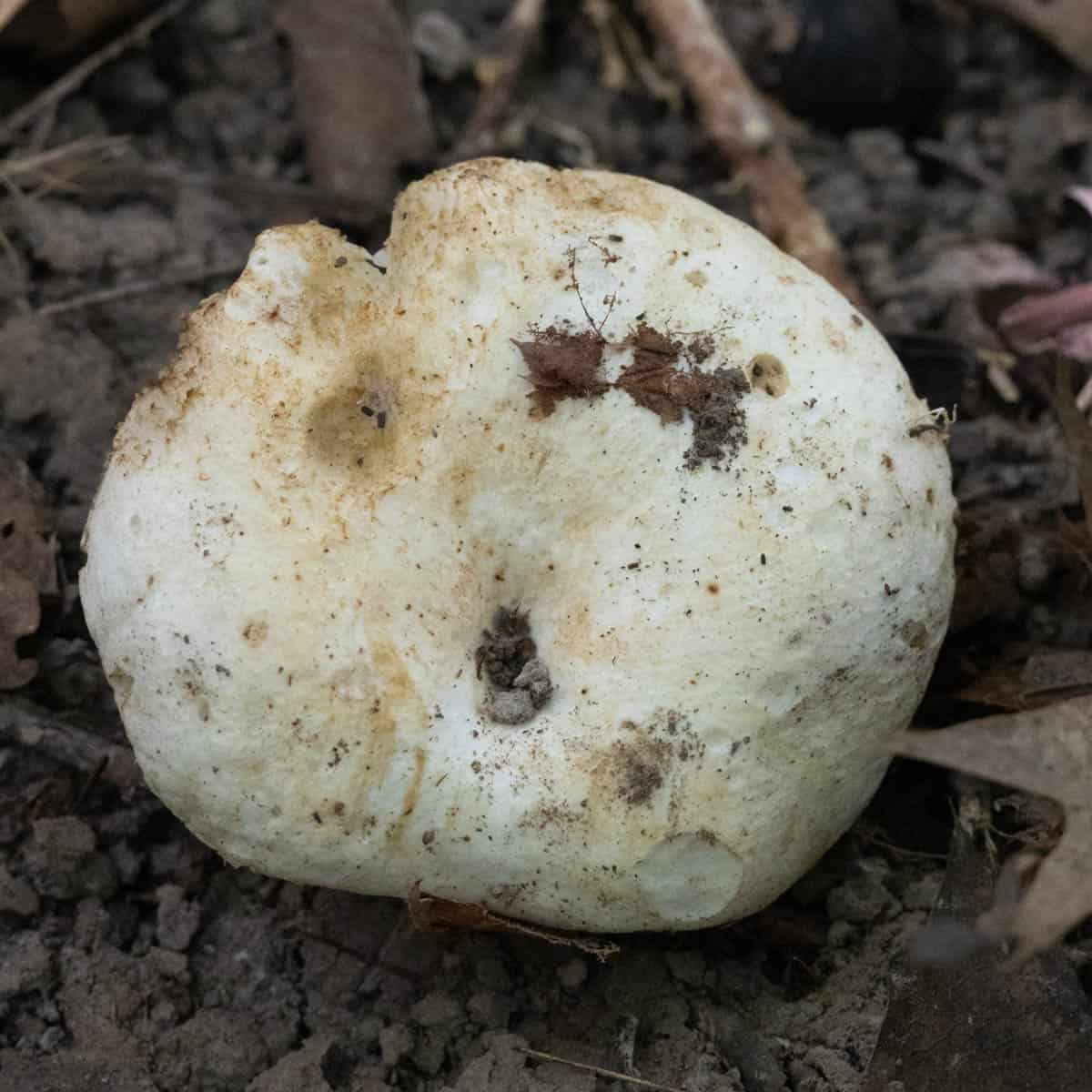
In Northern Minnesota, I find them in mixed woods with birch, aspen and red pine. In Southern Minnesota they like mixed hardwood and oak forests.
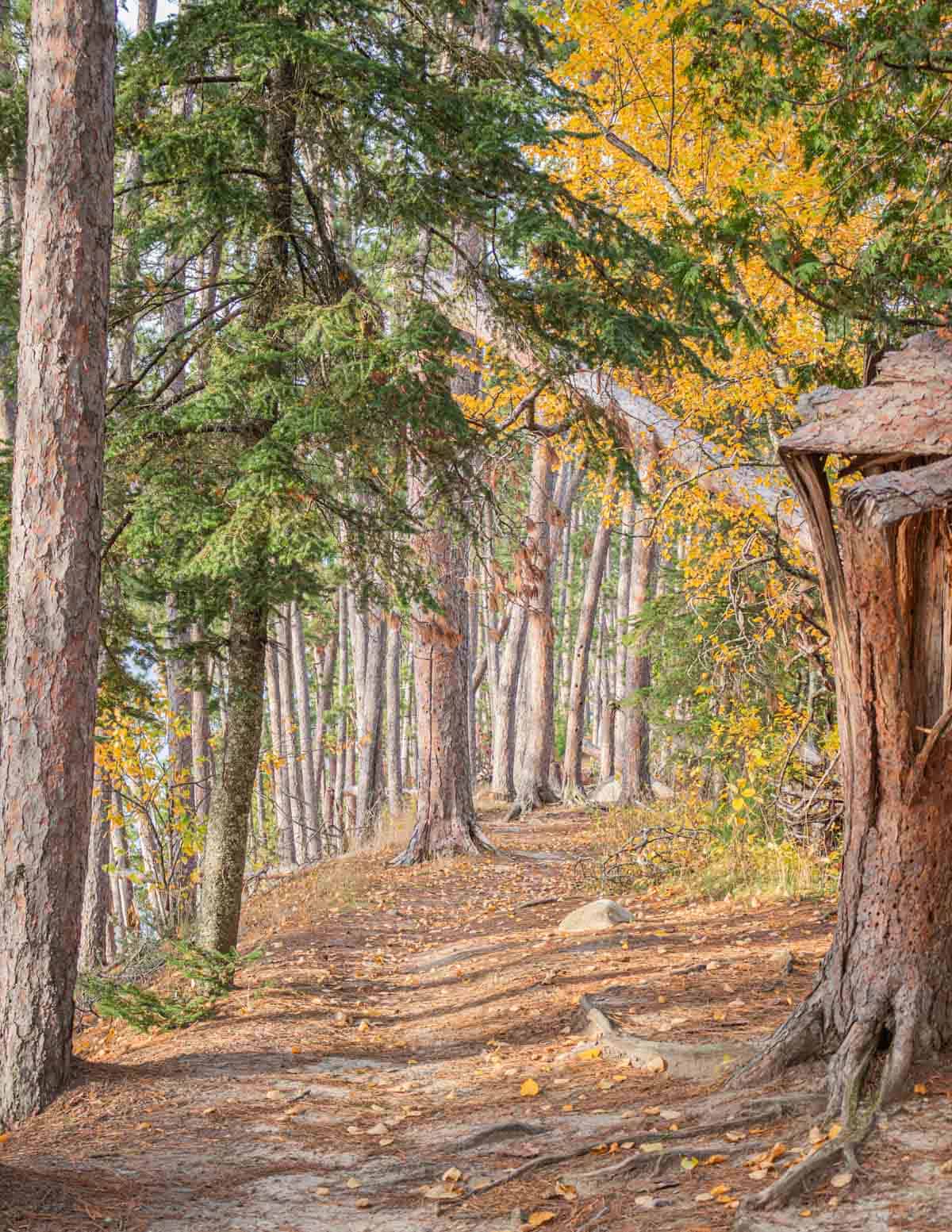
In the Midwest, lobster fungi season will start around mid summer (late July-August) and can go through September. In the Pacific Northwest where they may grow with Ponderosa pine, the season will go longer into November. They're sold commercially in the fall.
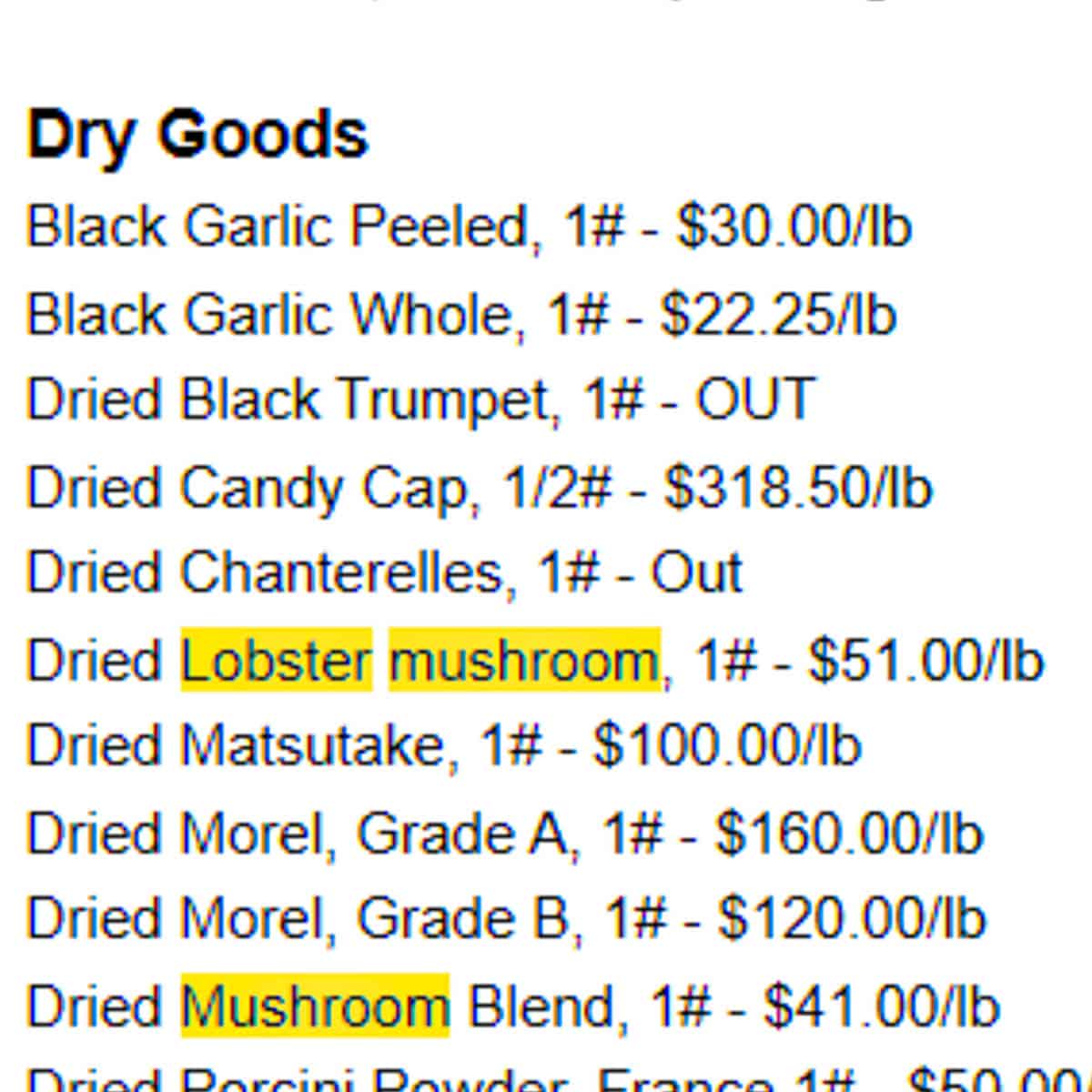
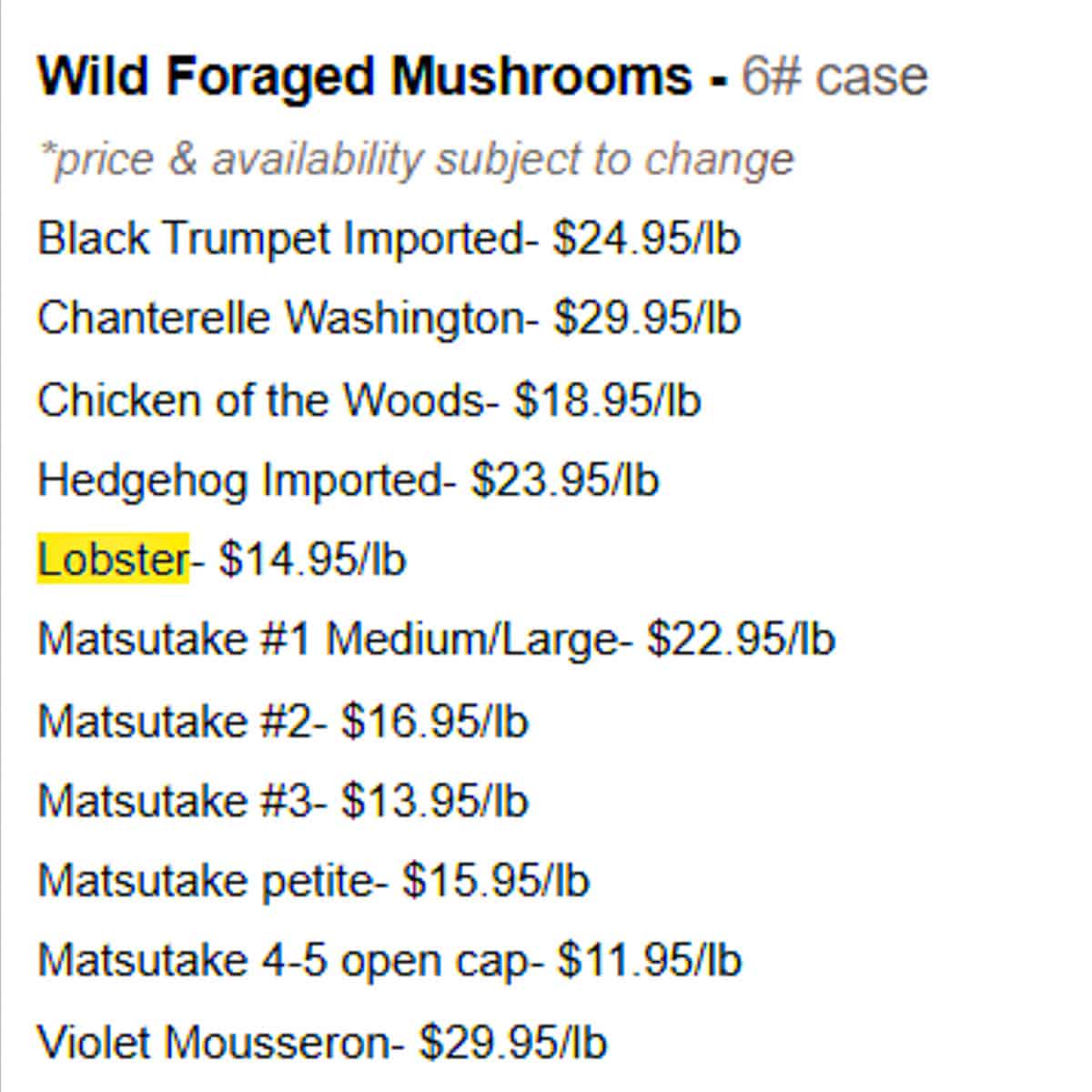
Are Lobster Mushrooms Poisonous?
No, but, like other mushrooms, some people are allergic to them and experience intense nausea, vomiting and diarrhea a few hours after ingestion. Lobsters are also said to contain some iodine, which could account for some of the fishy aroma. Reactions from people with shellfish allergies have also been reported but should be considered anecdotal until we know more.
Harvesting Lobster Mushrooms
A perfect mushroom should be heavy like a paperweight. If the mushroom feels light like Styrofoam, has a strong fishy odor or dark purple color, they're too old to eat. Old lobsters also have a reputation for making people sick. On a side note, old purple mushrooms are the best for making lobster mushroom dye.

Older mushrooms are good for dehydrating. These are one of the best mushrooms to make into powder.
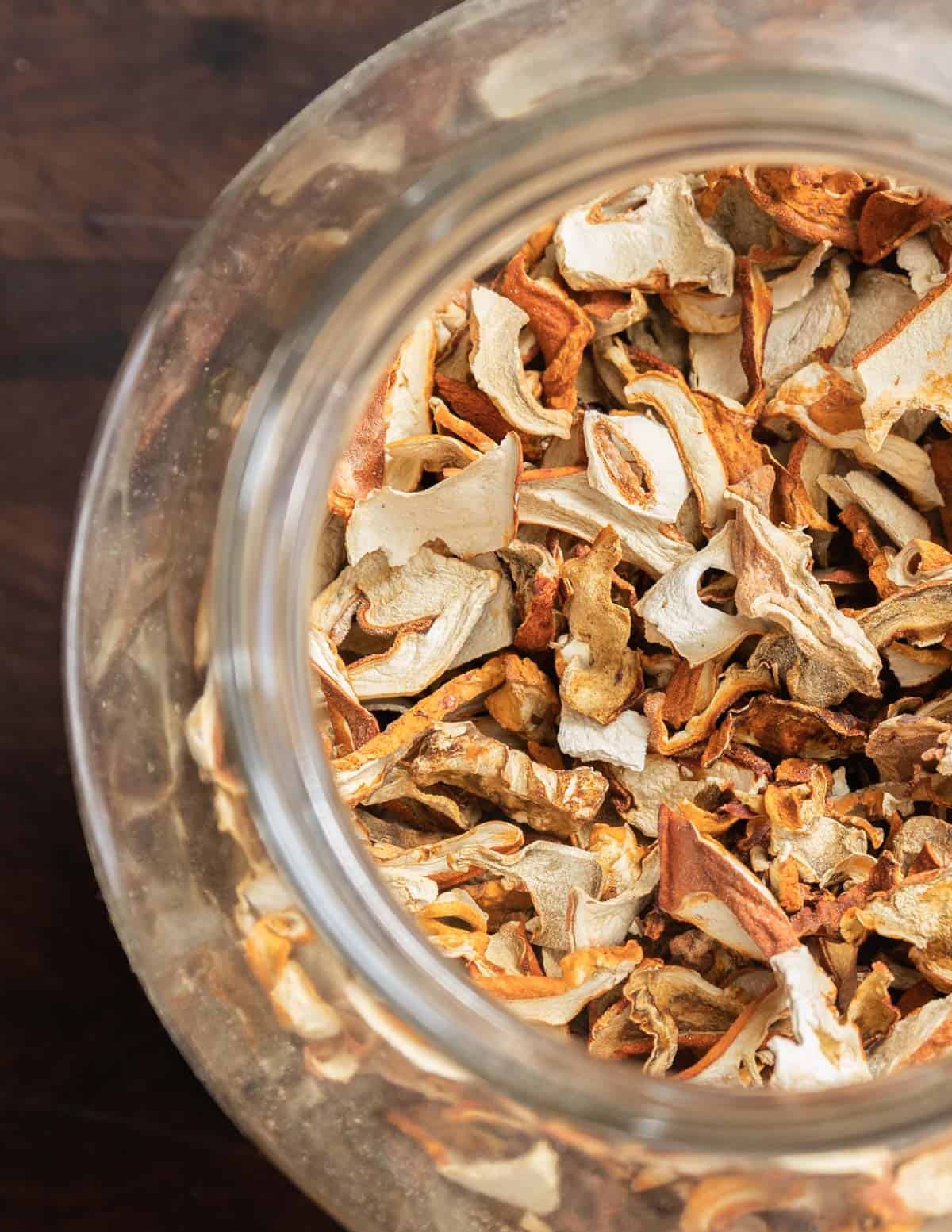
Cleaning Lobster Mushrooms
Lobsters can be vase shaped, filled with small creatures, dirt and rainwater. When picking, trim the dirty ends from the lobsters, use a dry brush to clean, then carve out the middle and any soft tissue using your knife.
At home, wash the mushrooms with cold water, then dry on towels. After cleaning, store the mushrooms in a Zip Loc bag with a dry paper towel.
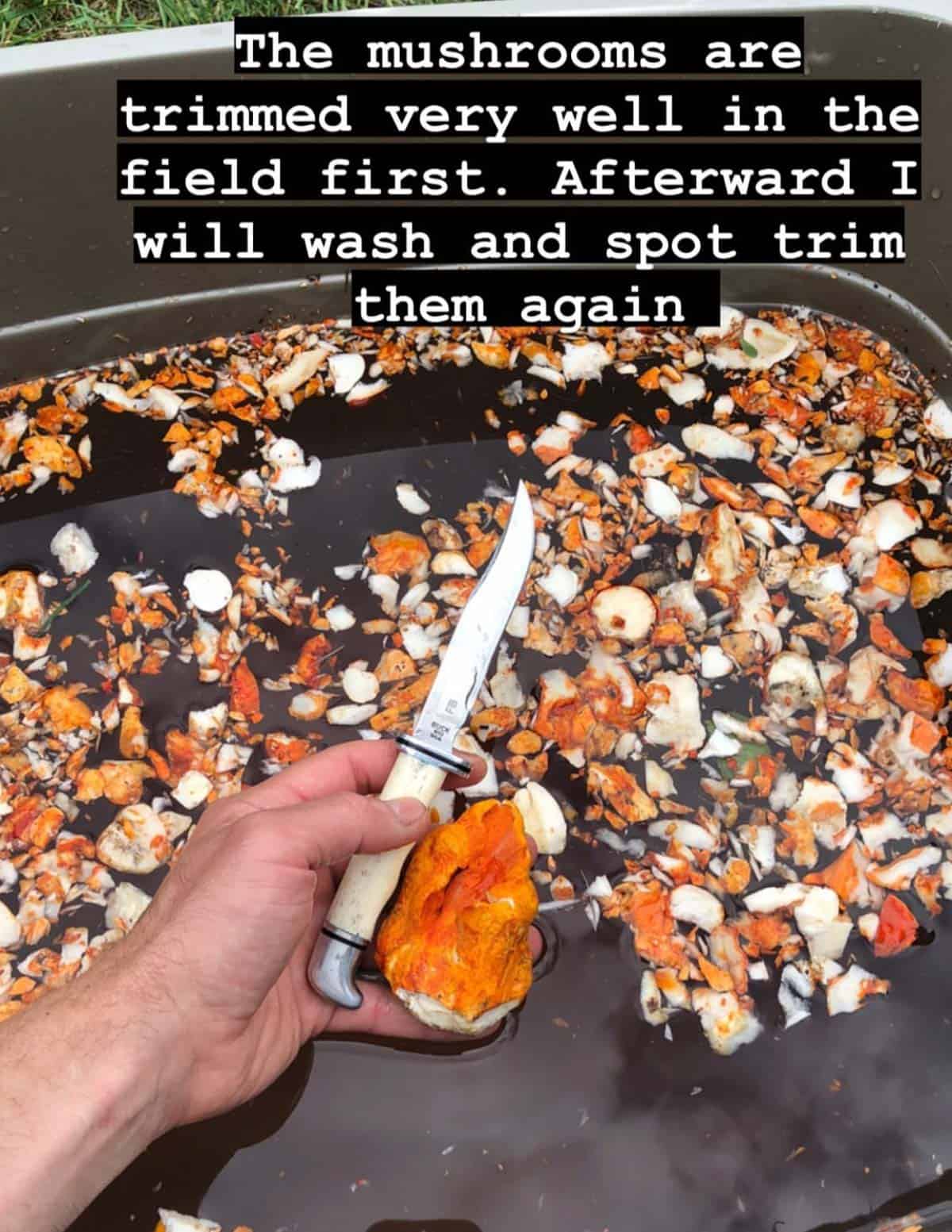
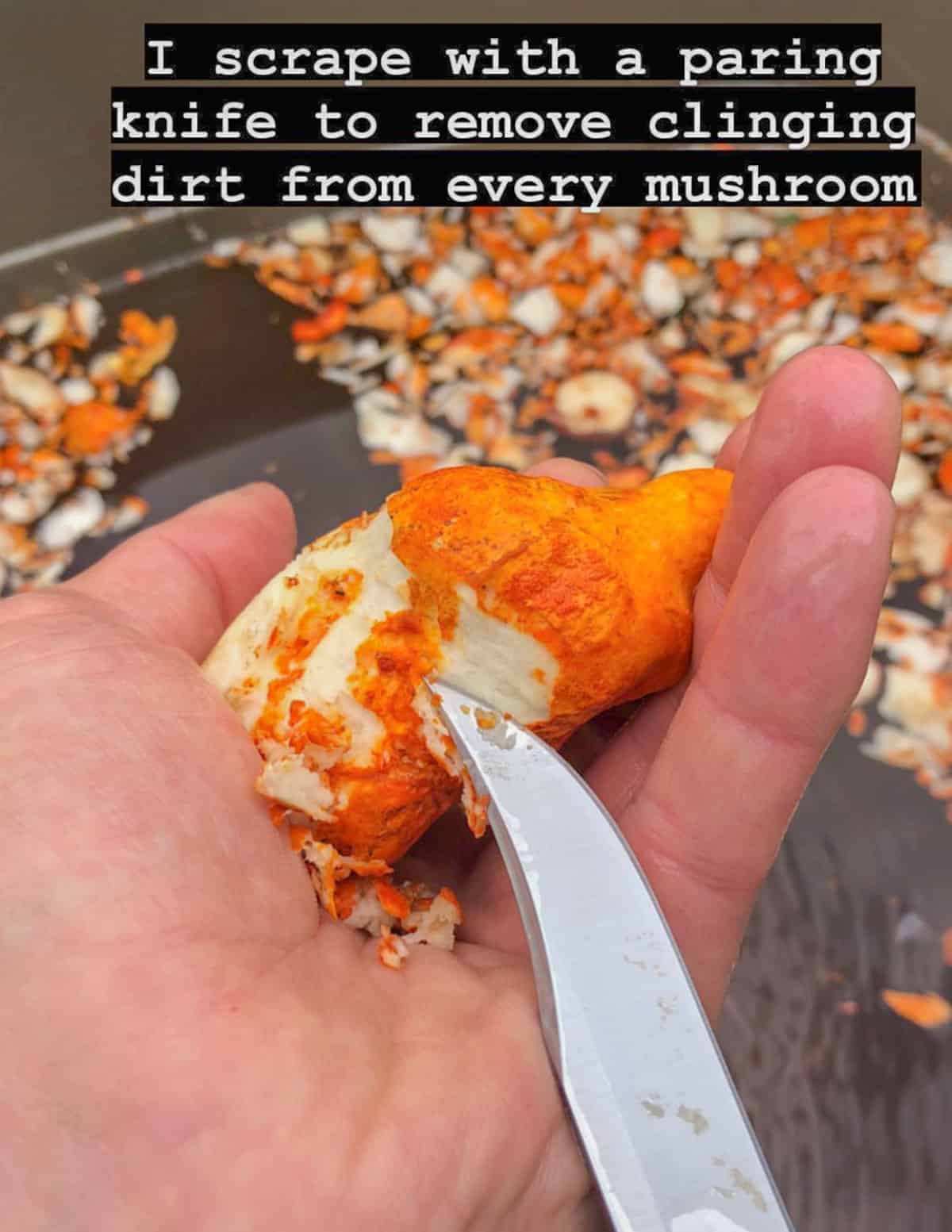
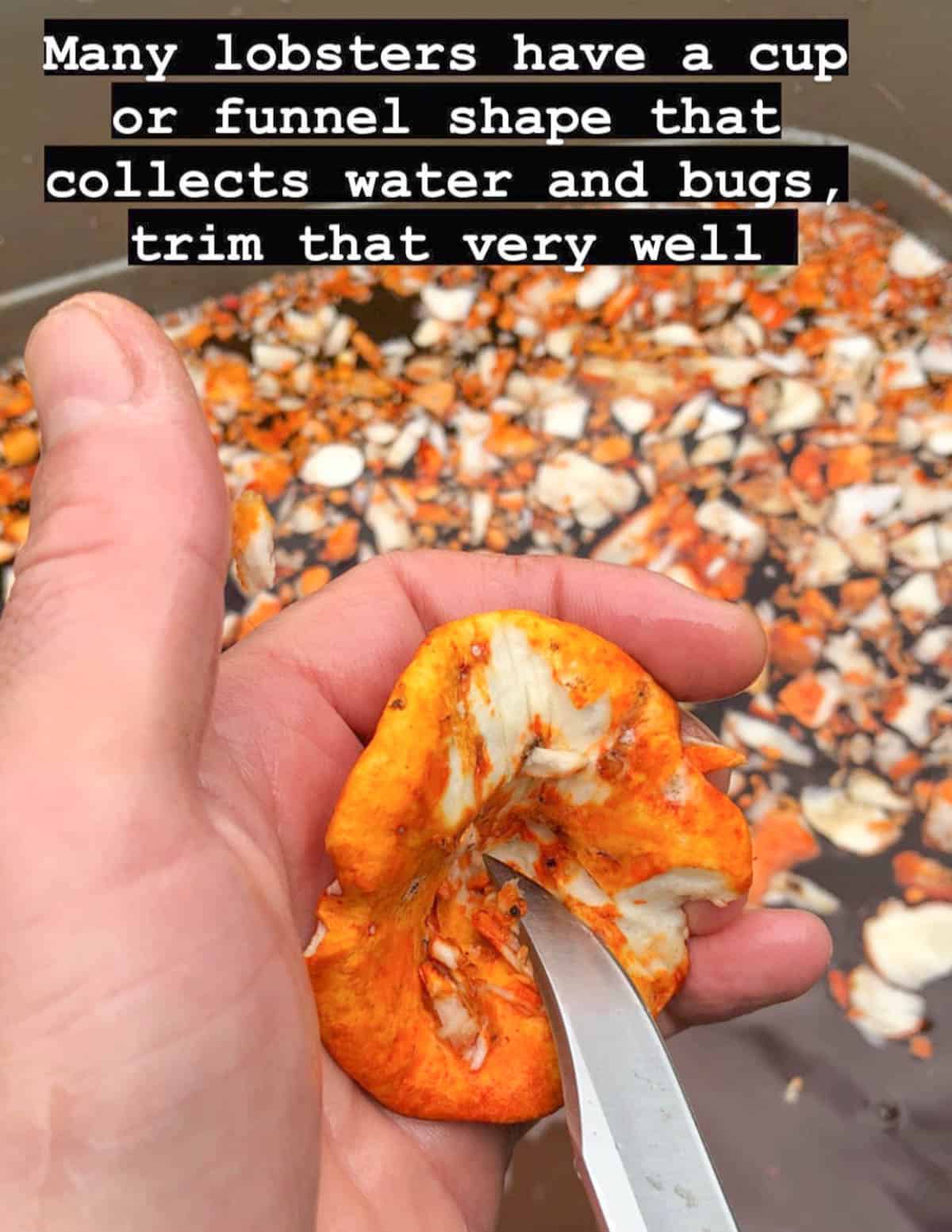
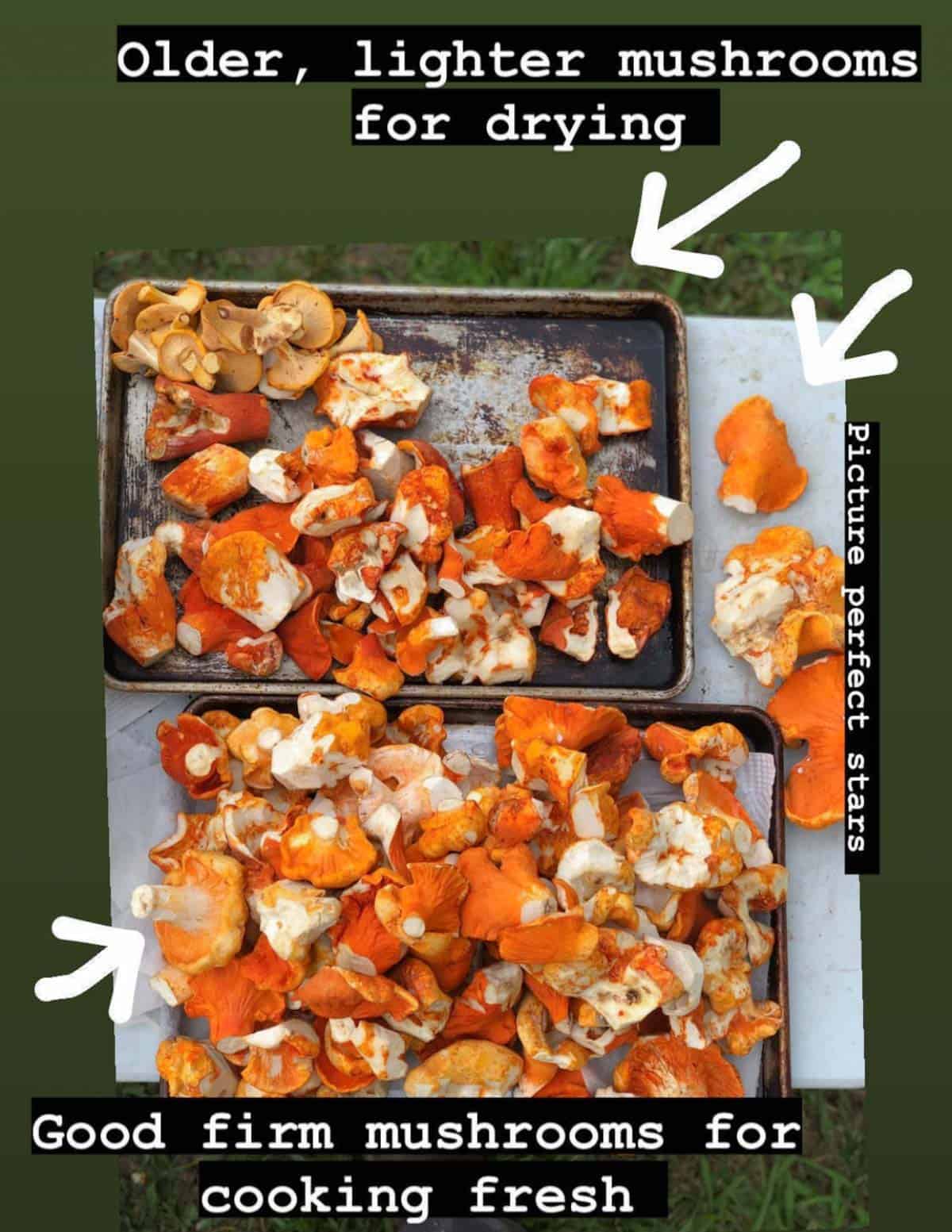
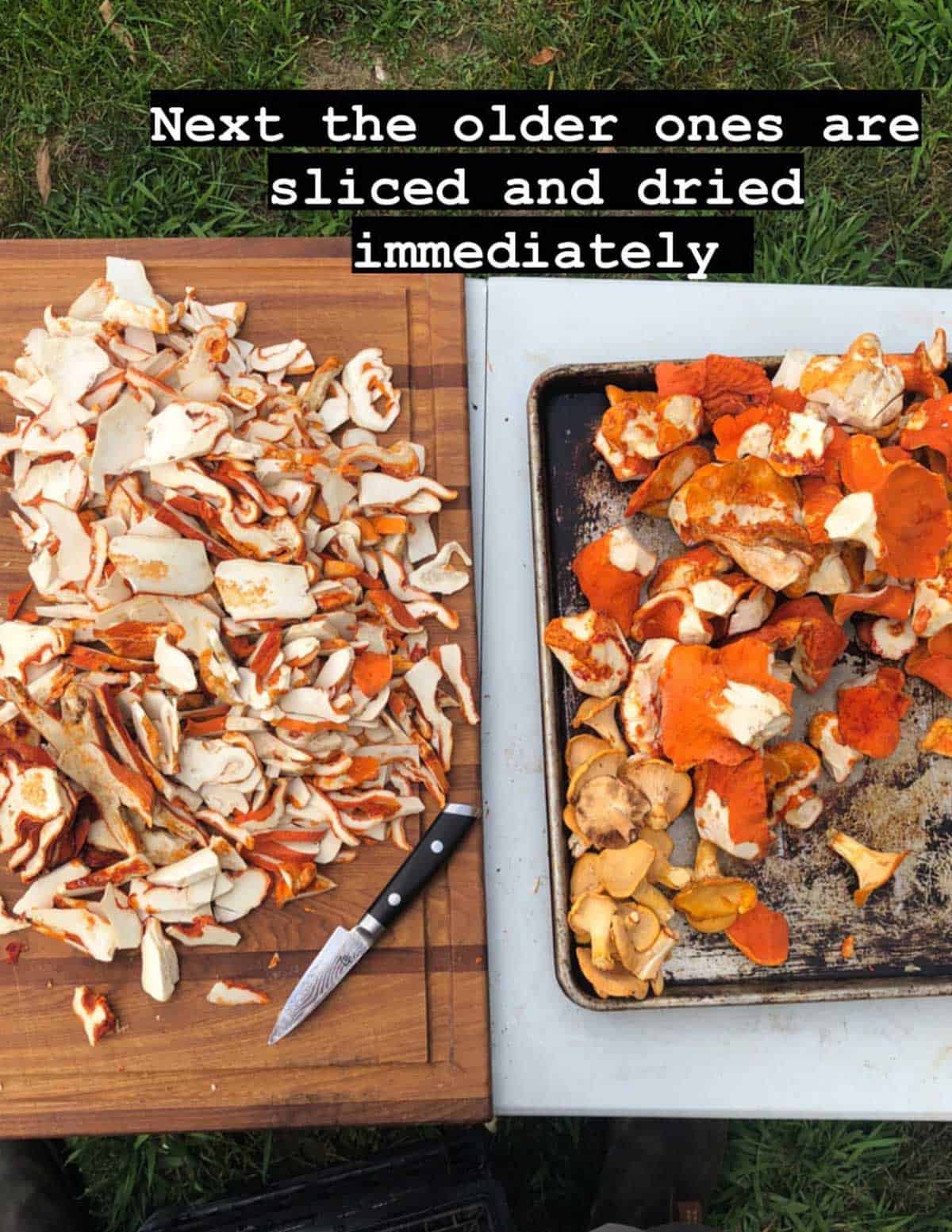
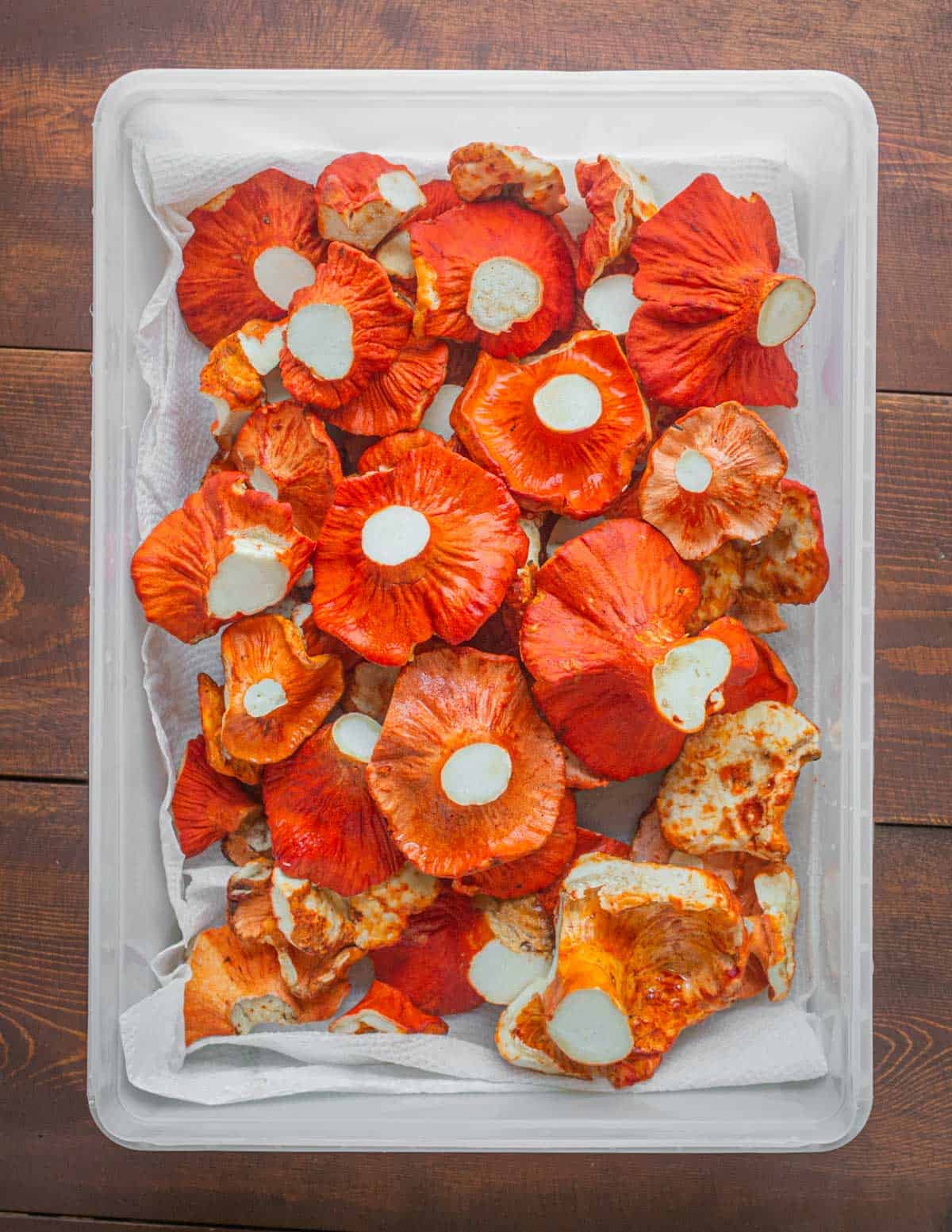
White Lobster Mushrooms
You may run into mushrooms that haven't been fully parisitized. After discussions with foragers, chefs, and mycologists, and serving hundreds of pounds myself, I can tell you that if it looks like a lobster, and is parasitized by the Hypomyces, it's edible.
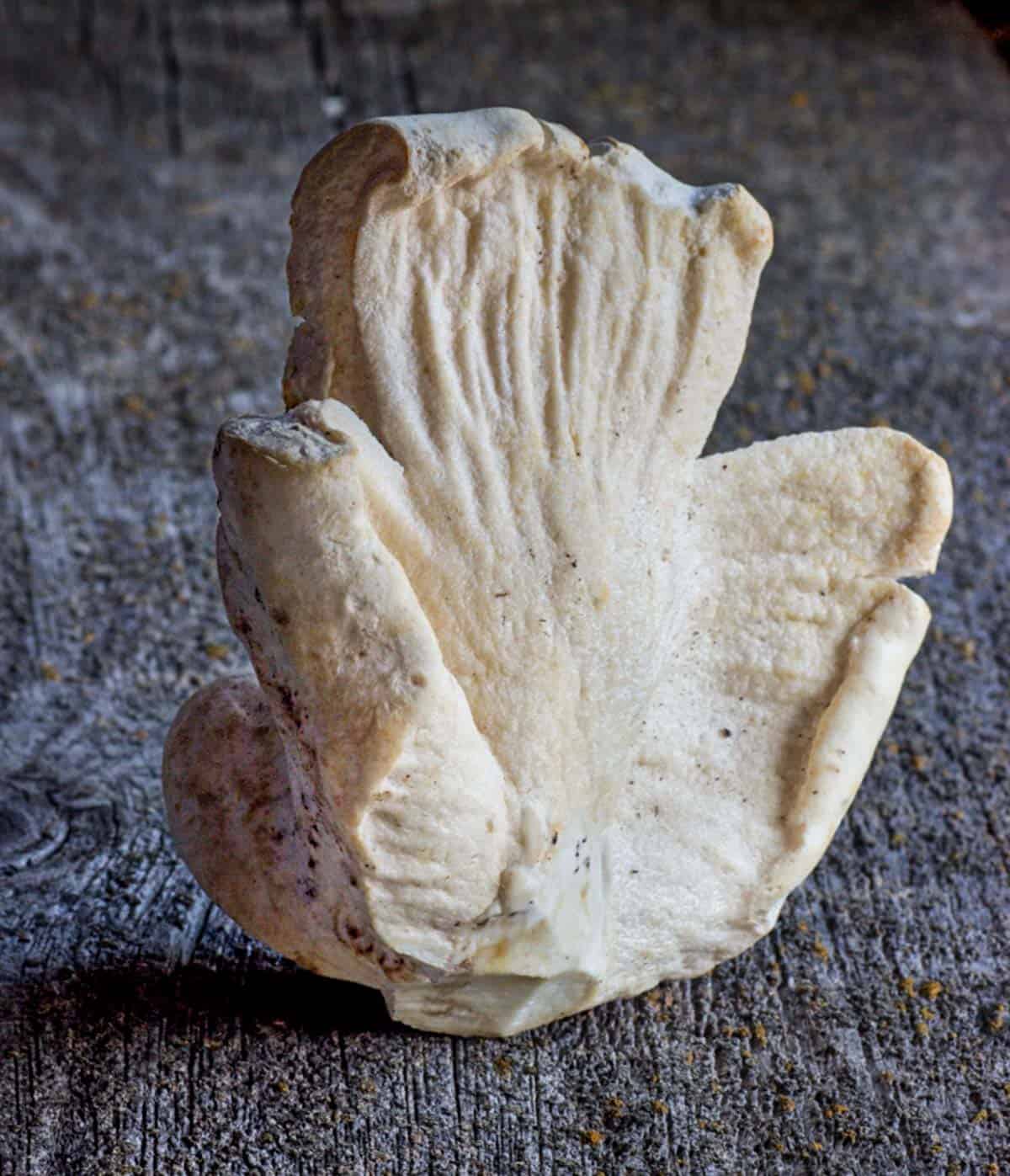
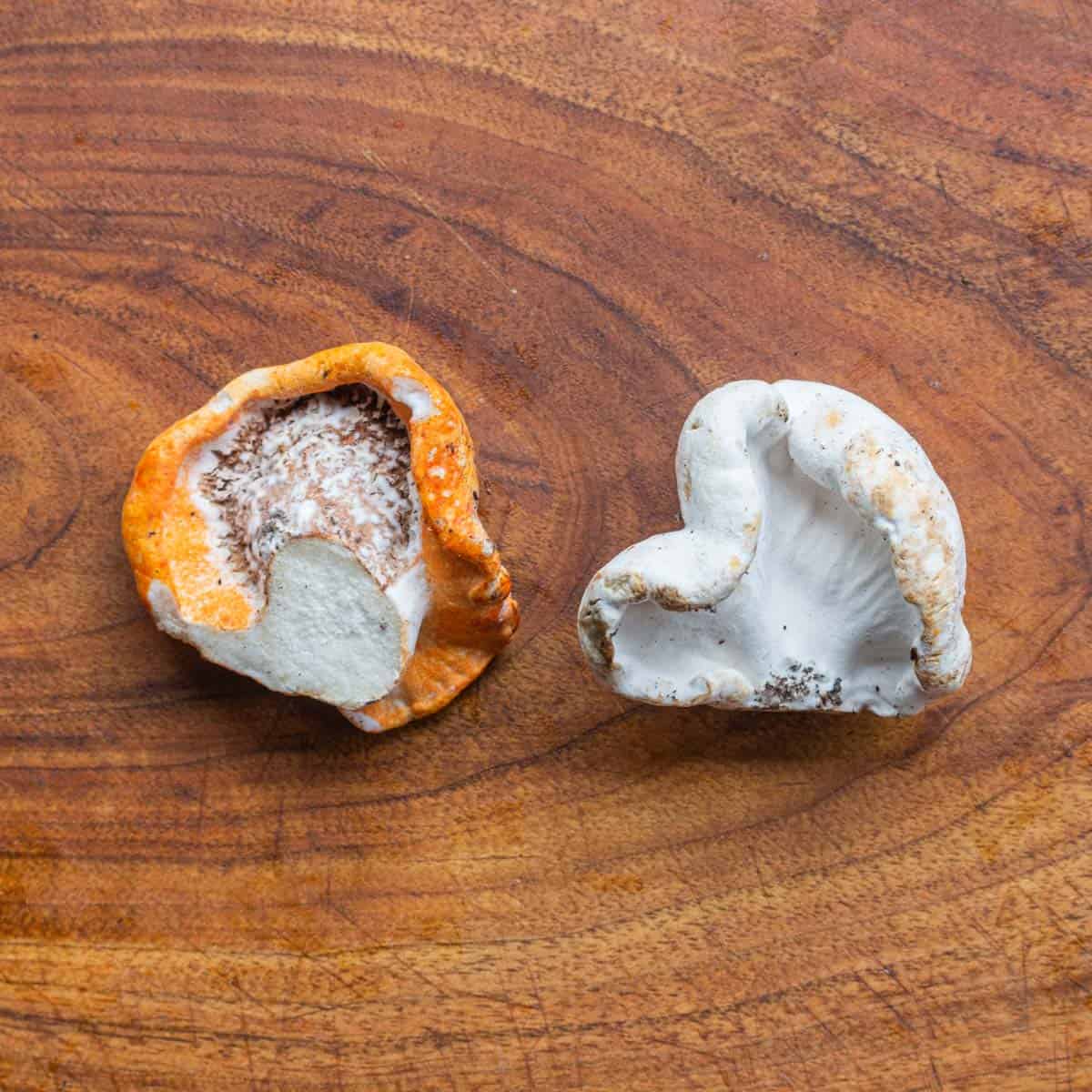
The exception is if the mushroom is half-parasitized, which is extremely rare (see below).
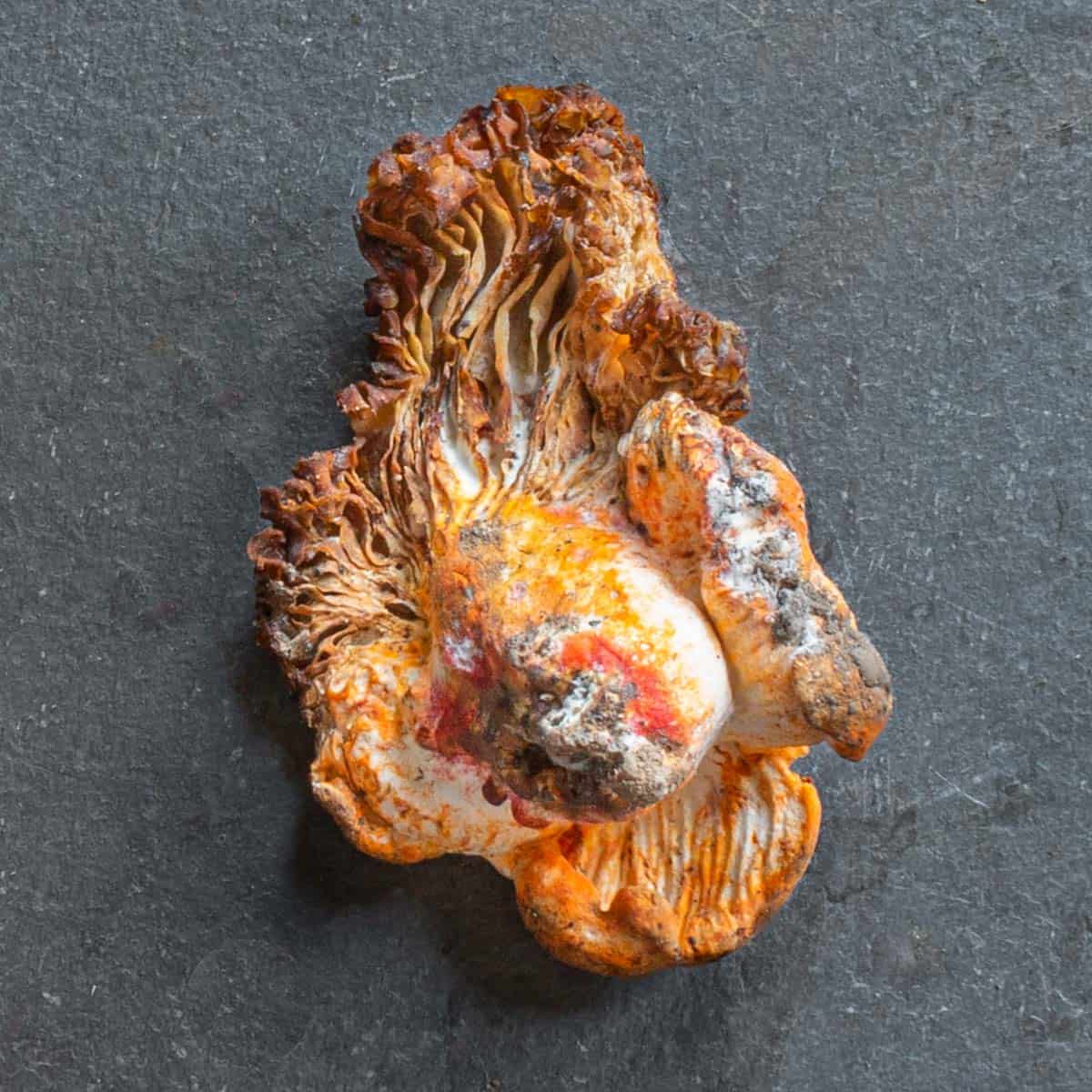
The Lobster Mushroom Taste
Fresh mushrooms have a very mild flavor and aroma of shellfish or crustaceans which intensifies when dried. Highlight the shellfish taste by using dried lobster powder.
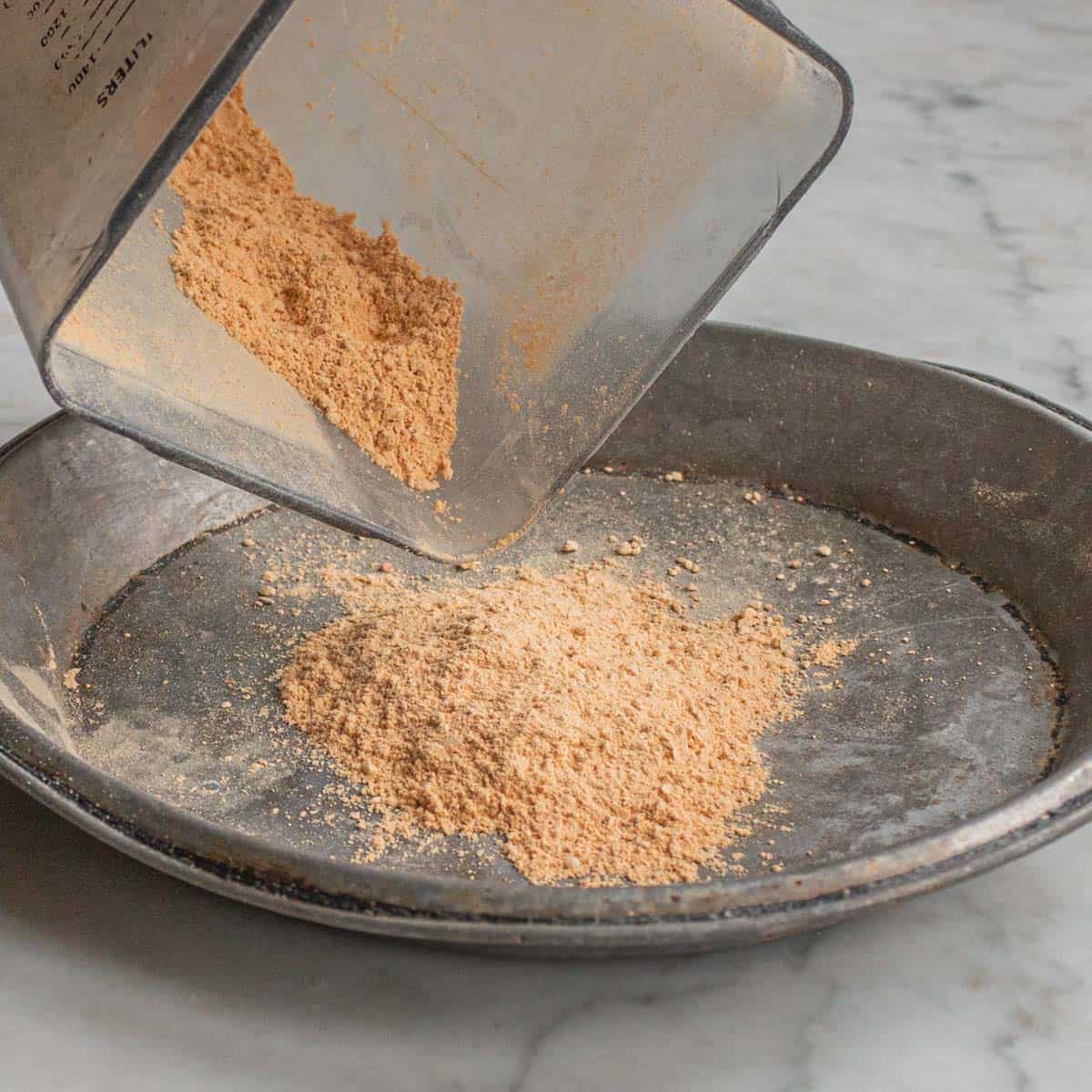
Cooking Lobster Mushrooms
I consider these a choice mushroom due to their size and texture. The only drawback is they lack flavor compared to other mushrooms like chanterelles. Enjoy their meaty texture in heavily seasoned dishes where they can blend into the background, like a curry.
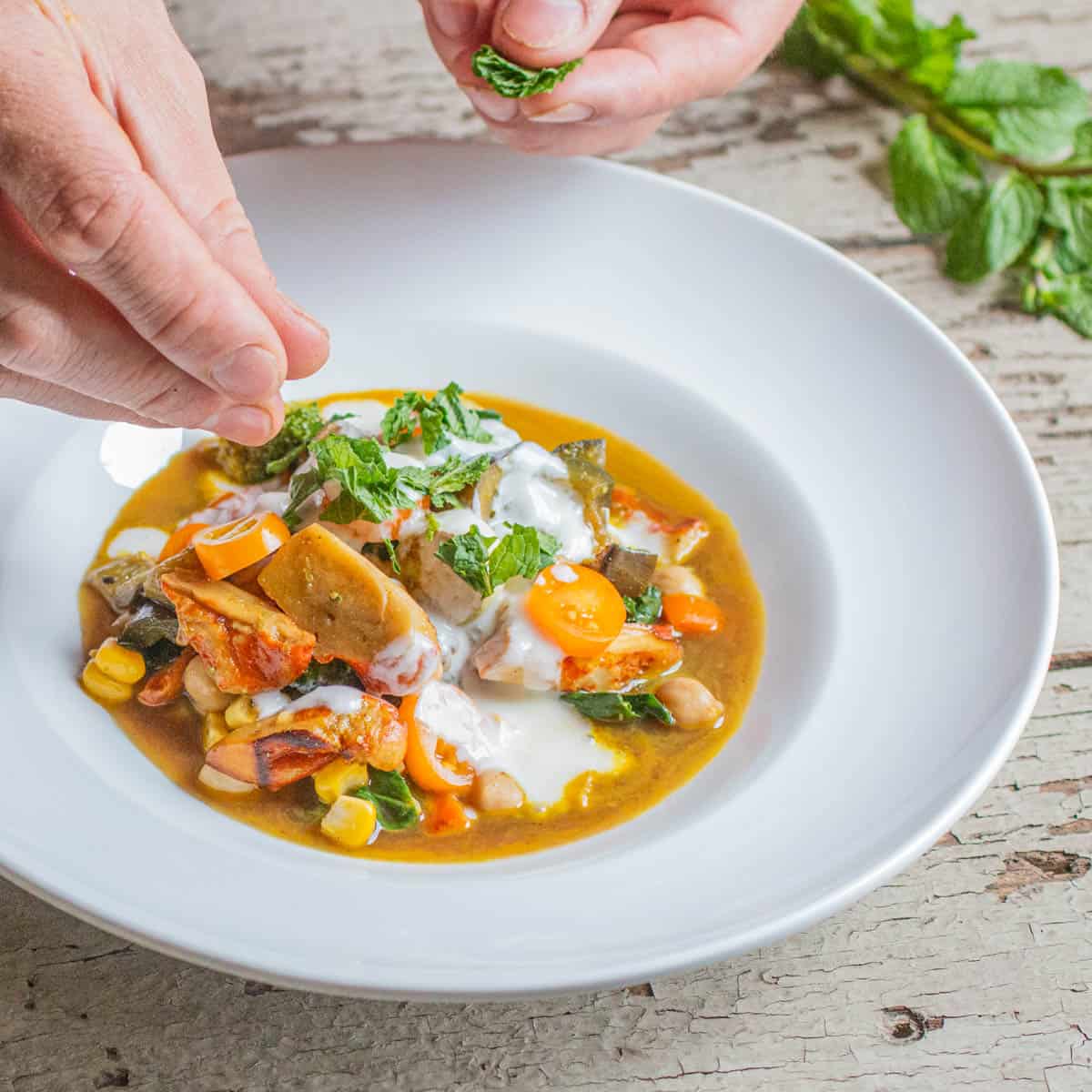
The first time you try them, cut them into large chunks or slices and saute in olive oil to taste their flavor, then get creative.
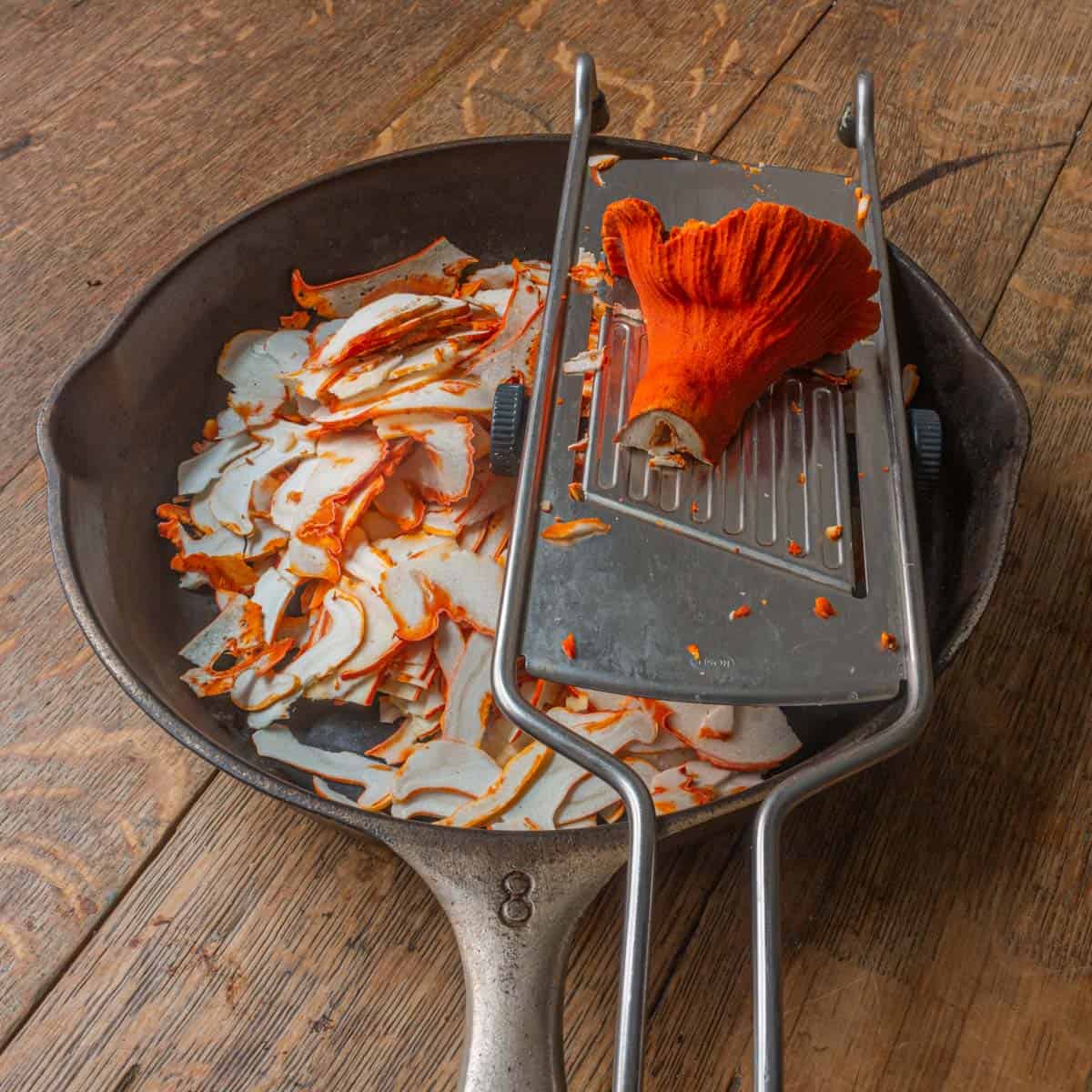
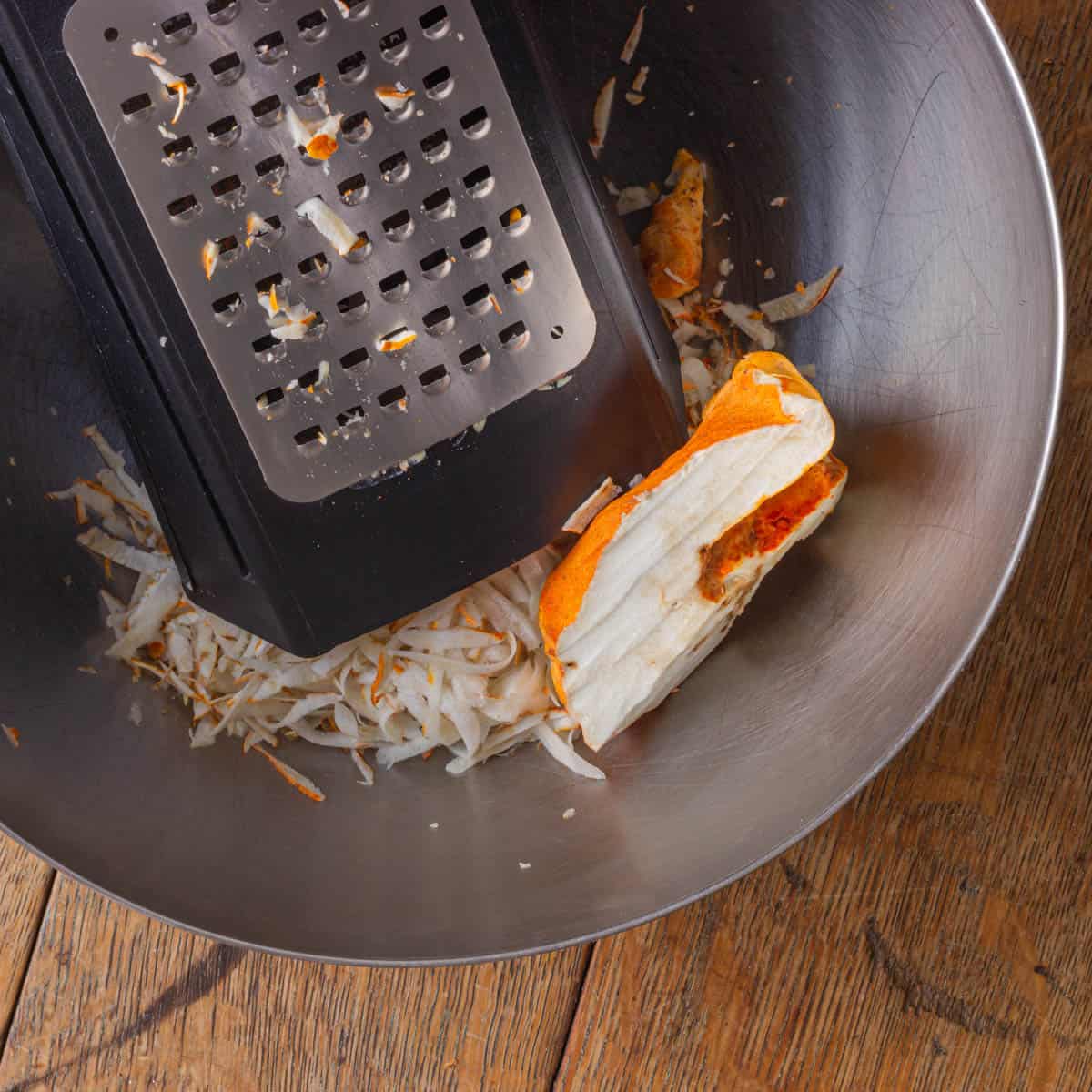
One of the best parts of the mushroom is their firm texture. They're so solid you can grate them like a potato and use them to make mushroom cakes like potato latkes or a pressed terrine as in the pictures below.
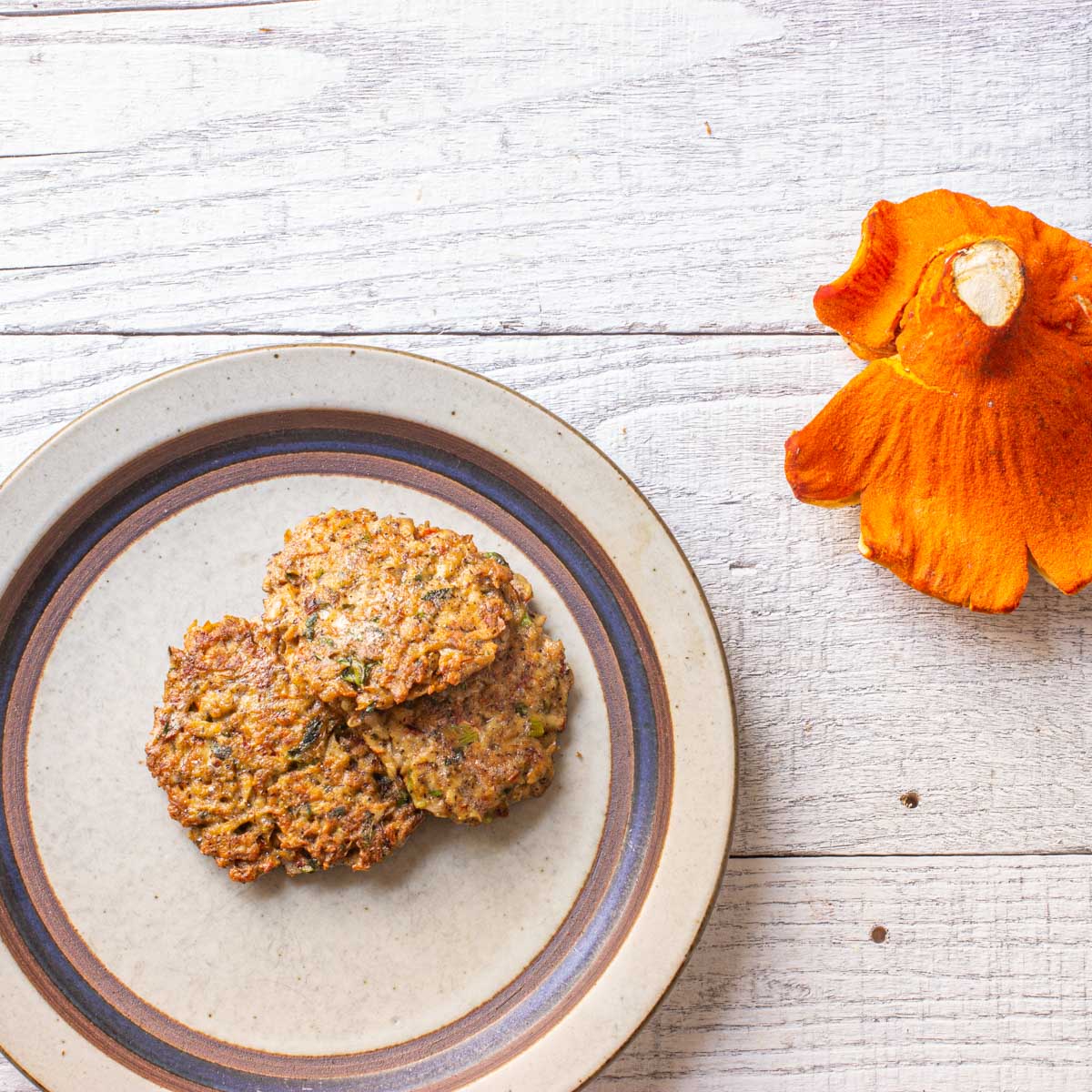
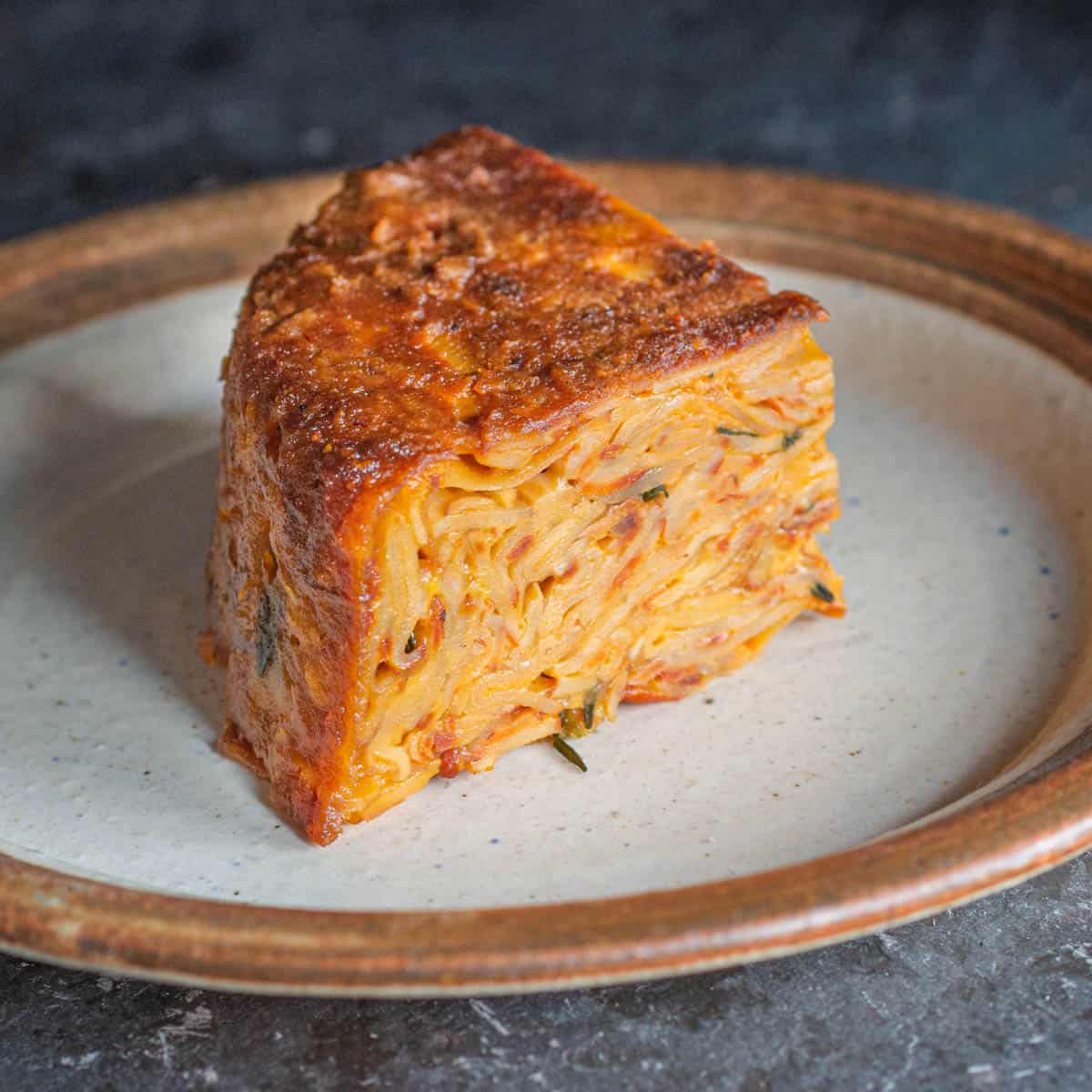
Cooking Tips
- Dried lobsters can become bitter if used in excess.
- These are great for fresh mushroom duxelles.
- The bright orange-red coating turns butter, oil or cream a brilliant orange color.
- Since lobsters are mild tasting, try mixing them with other mushrooms or cooking like potatoes.
- Eat leftover cooked mushrooms within 2 days, and make sure to reheat them.
- Their size and texture make them perfect for vegan and vegetarian and vegan mushroom recipes.
- Freeze lobster mushrooms by cooking in butter with salt, then sealing in a freezer bag.
Here's a few ideas to get you inspired.
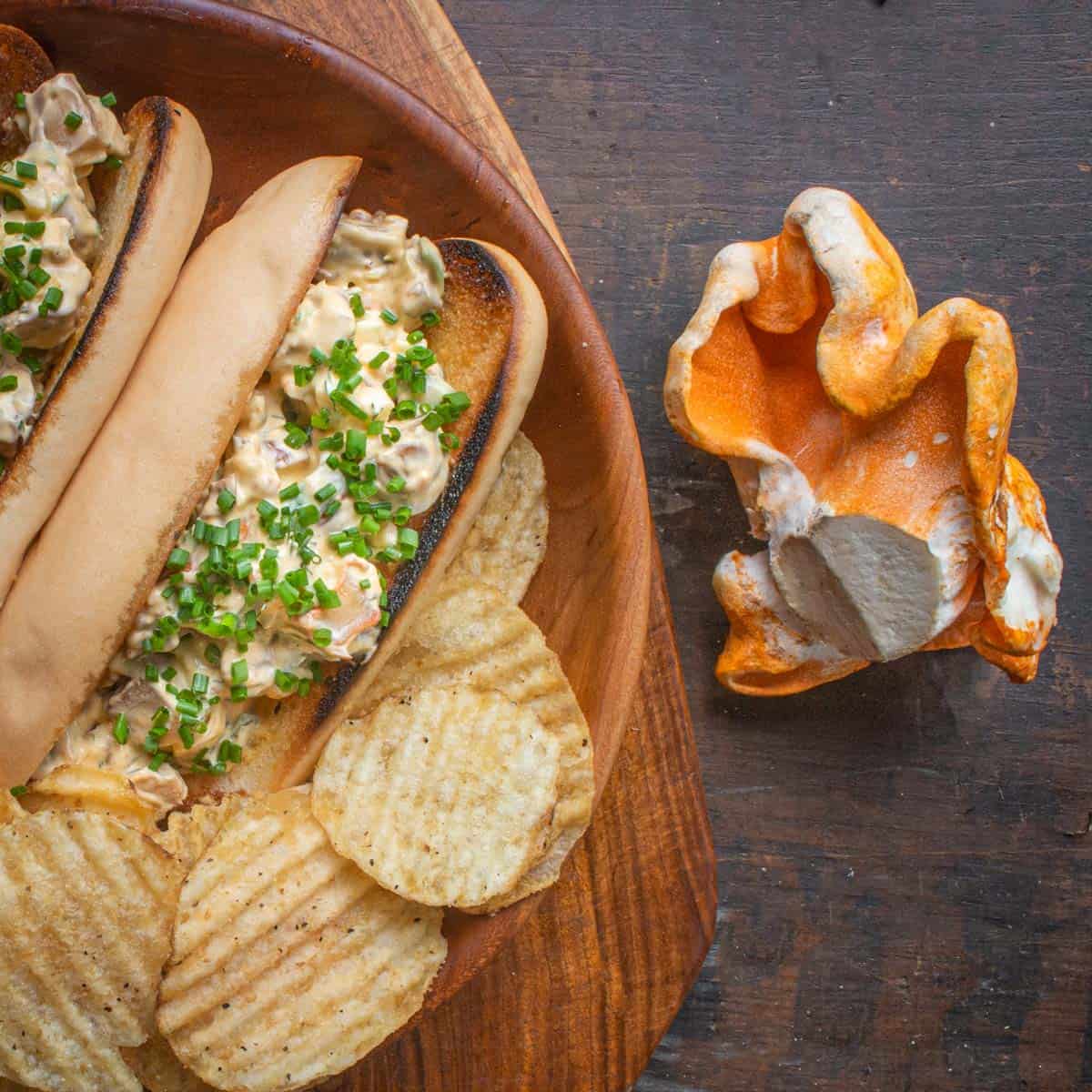
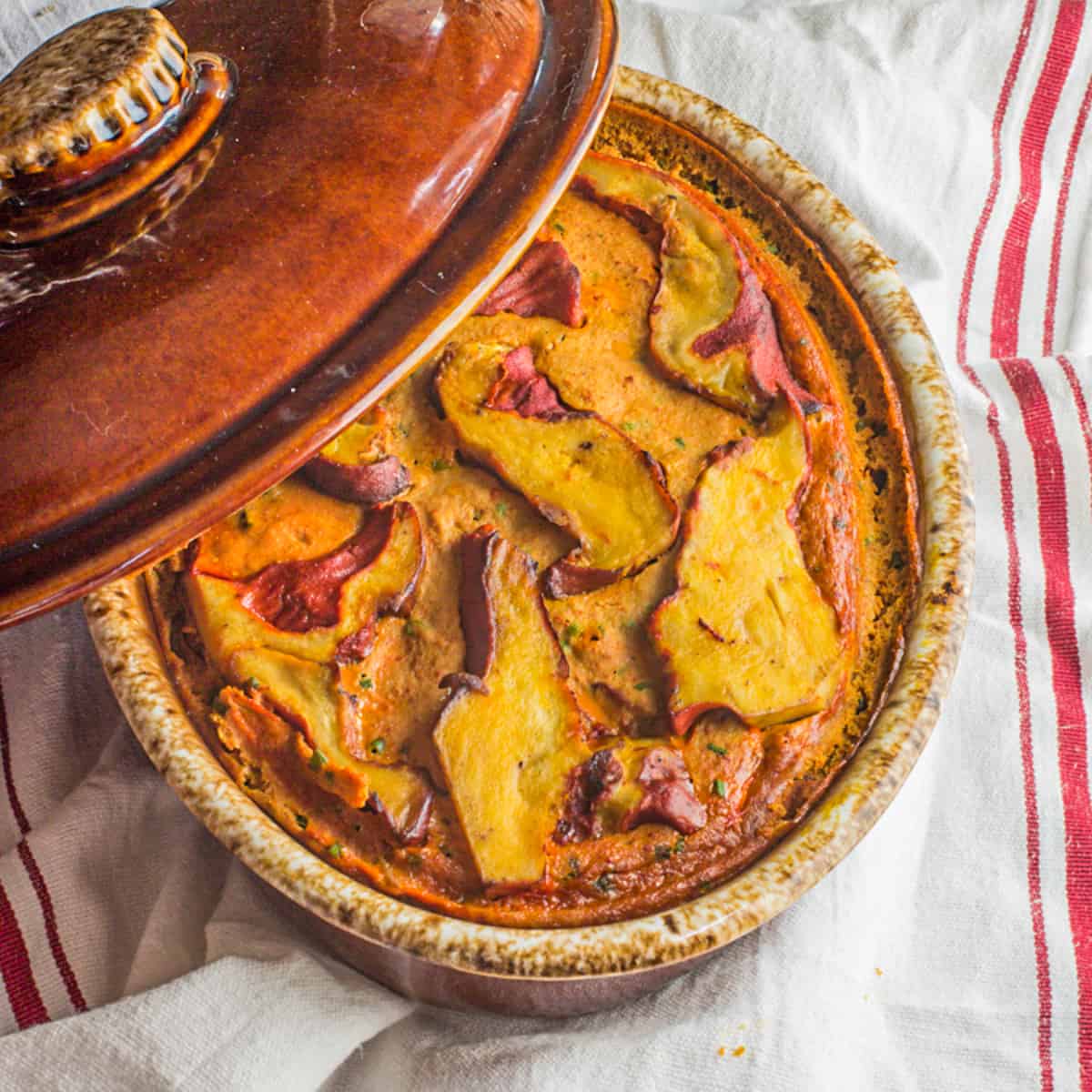
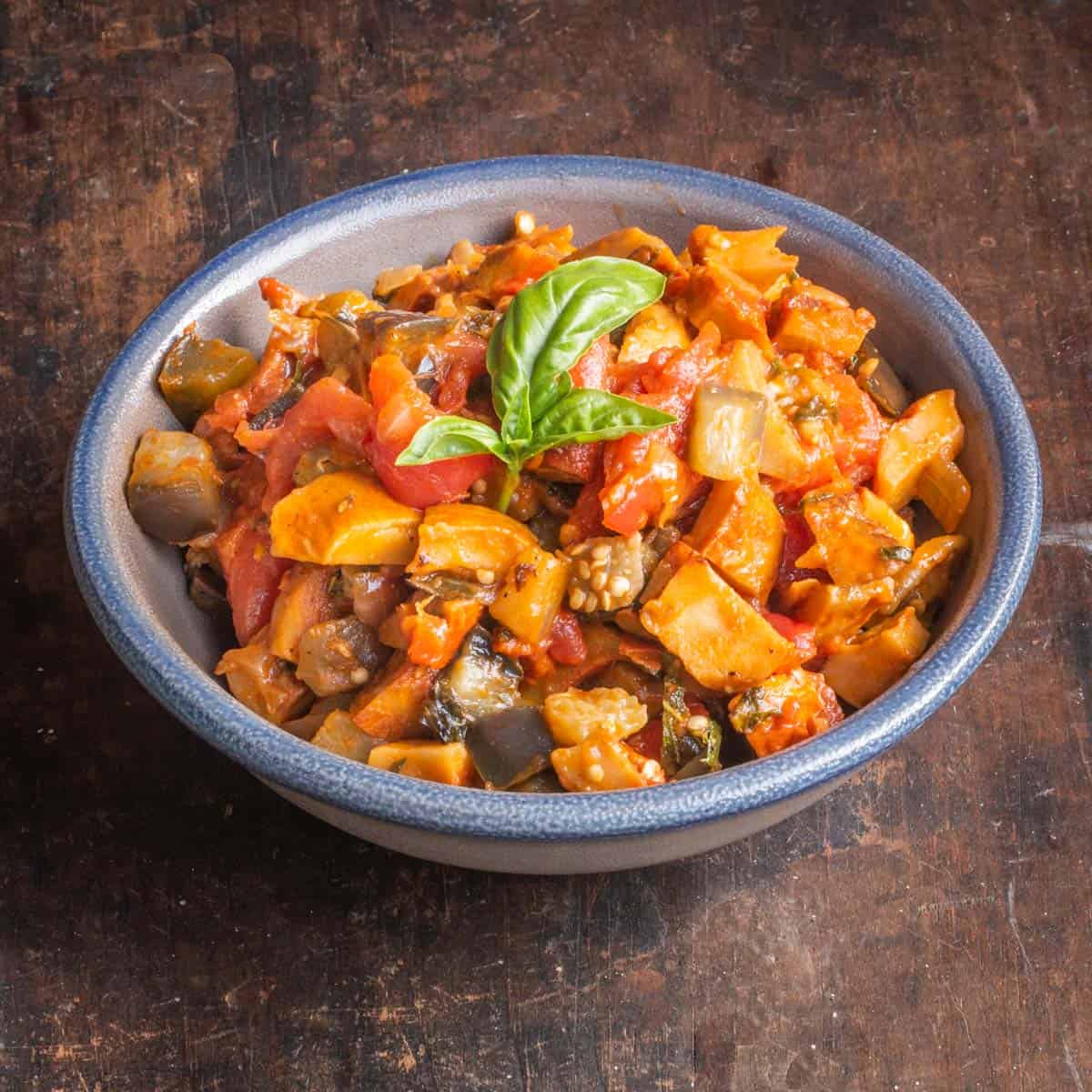

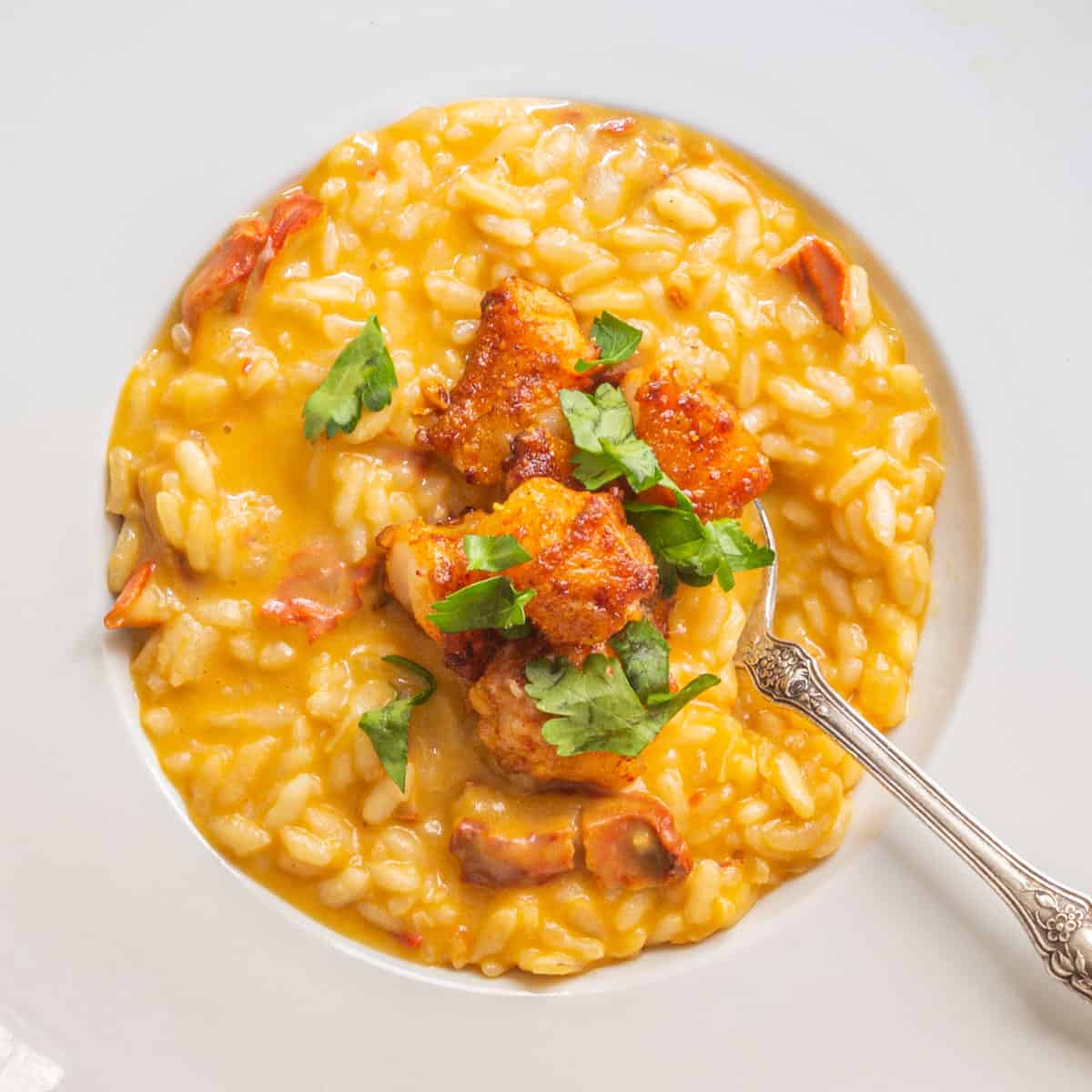
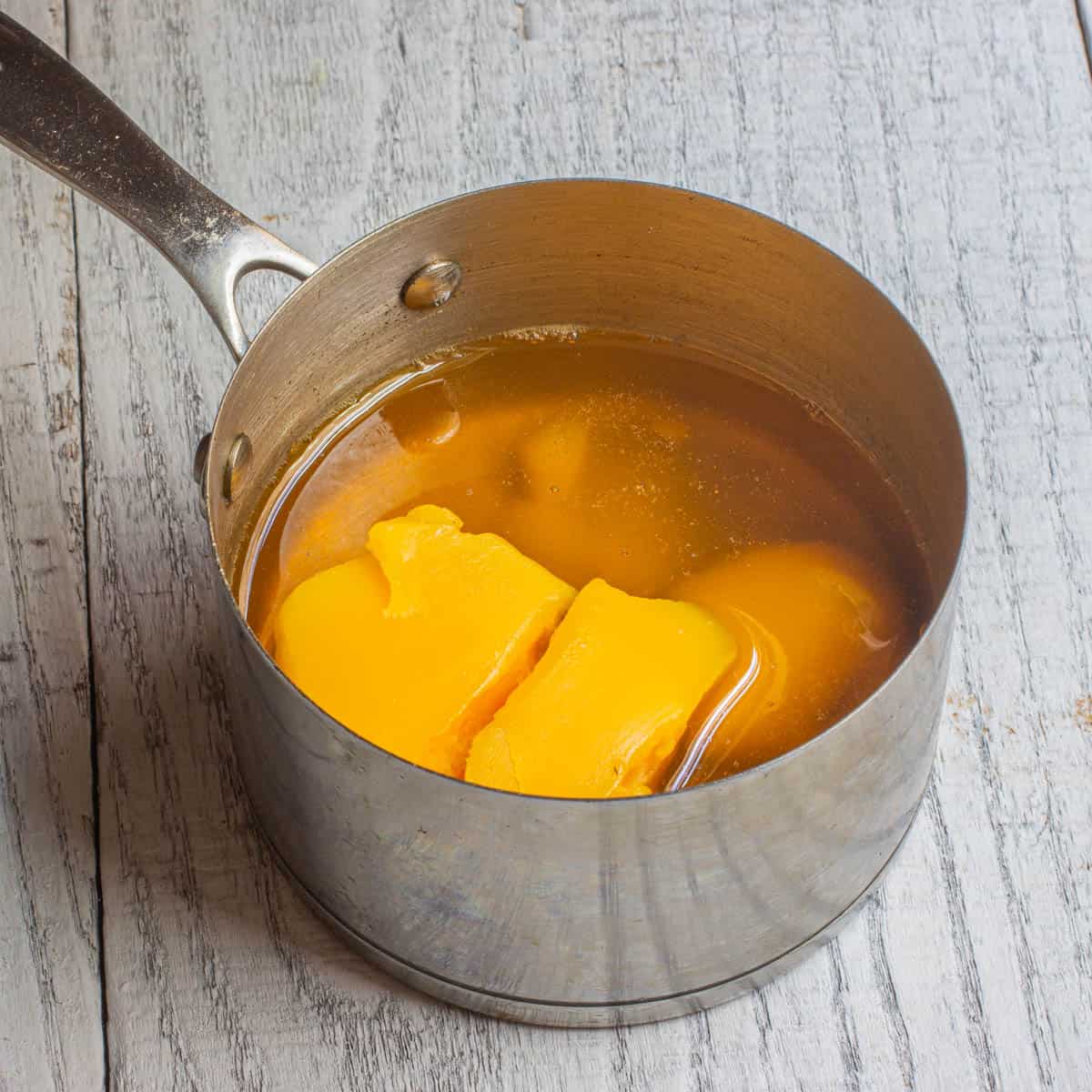
Lobster Mushroom Recipes
- Lobster Mushroom Rolls
- Braised Lobster Mushrooms with Tomato and Leek
- Wild Mushroom Conserve
- Lobster Mushroom Butter
- Lobster Mushroom Cakes

Norah
Do you have the pressed terrine or pave recipe shown in your picture above?
Alan Bergo
Yes it should be on my site. There's lots of recipes for lobster mushrooms.
Dave Hilt
I make a great baked ratatouille, it features some big shitake shrooms, if I boil them first before the bake do you envision this working? Have never used 'lobsters' before and was just gifted a gallon jar of them dried perfectly, they are great looking, brilliant in color! Picked at perfect timing it would seem from your guidance above.
Alan Bergo
Hi Dave. Dried lobster mushrooms are not the same as fresh, if you want to use them I'd try my dried lobster mushroom bisque. If you want to use the shiitakes in a mushroom ratatouille I would lightly brown or roast them first.
Arni
Loved the article! Do you have a good recipe for lobster mushroom risotto? Thanks!
Alan Bergo
I do but it’s not on this site.
Arni
Loves the article! Do you have a good recipe for lobster mushroom risotto? Thanks!
Jean
Hi, I have a shellfish allergy and am a little afraid to eat lobster mushrooms.
No biggie- I can eat others. However, I recently got a bottle of wild mushroom starters 002 by the acid league and lobster mushrooms are listed as one of the ingredients, what do you think? As always, thank you, Jean
Alan Bergo
I'm unfamiliar with that product. Can you clarify a little here? I think it'd be fine to sample a small amount.
Diane
The mushroom has no genetic link to lobster or shellfish. It is the color and the scent that gave them this common name. Your shellfish allergy will not effect you earing this mushroom. People can have allergies to mushrooms but this would be unrelated to your shellfish allergy.
MaryW
Hiya - just found this older post and used it to make decisions about whether the lobster mushrooms I got in my CSA box were too old to eat, how to prep them, and how to cook. The butter sautéed slices with thyme and salt were amazing, Thank you for sharing what you know 💕
Alan Bergo
Thanks Mary. Unfortunately, worrying about your lobster mushrooms age in a CSA box is a real thing, and old lobster mushrooms will definitely make some people sick. If they're covered with white spores, feel very light or hollow (they should be heavy like a paperweight) they should be discarded. Glad you had fun with them.
Tatyana Beer
Oh no. I just processed a couple of pounds of lobsters using your confit recipe… except once I’d chunked them up and added the salt and herbs we had a few very hot days so I didn’t want to have the oven on to roast them… I left them in the fridge, marinating, for about three days before cooking, bagging and freezing. Now I’ve stumbled upon this post warning about eating old lobsters… am I going to have to toss this batch, or do you think the salt will have kept them food safe during that refrigerator time?
Jenny Koczur
I know this is an old post, but I have some info to add— lobster mushrooms make a fantastic natural dye! If they’re past their prime, all the better. The old nasty smelly ones make the strongest dyebaths. You basically simmer them, strain out the mushroom, and add yarn. You can get pink with an alkaline bath all the way through coral to yellow with a neutral or acidic bath. There are lots of other places to sort out the nuances of natural dyeing, so I won’t elaborate here. When I find one that’s good for eating, I sometimes peel it & use the flesh for eating & the “peels” for dyeing.
Alan Bergo
Great info, thanks.
Goju
Thanks for sharing this knowledge!
Given their firm texture, would you recommend cooking in water first to soften and then sautéing? Or just to sauté until they surrender?
What would be the best way to freeze lobster mushrooms? Would you recommend sautéing first then freezing? Cooking?
Thanks!!
Alan Bergo
Saute, they have a light enough flavor as it is, so boiling them will leech out even more, which I wouldn't want. Sweat them in plenty of fat, and vacuum seal is my first choice.
Tracey
I have a question, am I able to fully cook the lobster mushrooms in garlic and oil, then quickly freeze them for winter? I've seen this done with other mushrooms, and I wondered if it's recommended here?
Alan Bergo
That's fine.
Cyndy
When you are done cooking them make sure to wait for them to cool down before freezing
Steven holt
I have a neighbor who vomits for days after eating lobster mushrooms that everyone else enjoyed.
Alan Bergo
Allergies like that are rare, but common enough to be a thing.
Brett Burdo
From what I’ve read, the underlying russula is what causes a lobster mushroom to be poisonous. If the russula the hypomyce parasitic fungi attacks was poisonous, the resulting lobster mushroom will be as well.
Alan Bergo
Nope. In all my years of cooking them from various host species to the general public, I would've seen large amounts of poisonings if that was the case. For all intents and purposes, it's either a lobster, or it isn't. What gets tricky is that you can find (rarely) some mushrooms that are half parisitized, which I wouldn't eat. I suspect some people are just picking past prime mushrooms, (easy to do for newcomers with these) and then cooking them and getting sick.
Tracey
For what it's worth, chaga mushroom has possibly cancelled the effects of other mushrooms (it grows on living trees). The theory is that chaga is the dominant fungus, and overrides it. Please don't risk your life on this information, it is just a possibility, to try in a pinch. Not to diagnose or cure any disease, for information purposes only.... And Don't try if you are allergic to chaga!
Alan Bergo
That's exactly why I don't permit any medicinal information on this site.
Hot Fungi 207
“Remember mushrooms are biologically closer to meat than mushrooms.”
Can you explain what this means...?
Alan Bergo
It is exactly how it sounds. From an eating standpoint, it is worse to eat spoiled meat than mushrooms.
Allison
Thanks for these recipes, Alan. I recently foraged 10+ pounds of lobsters and need all the ideas I can get!
Alan Bergo
You’re welcome! My advice: make the cakes first, they’re hands-down the audience favorite.
Mariann
I hadn't heard the allergy rumors, but I know that I've eaten them twice and got violently ill (vomiting all night) both times. No one else got sick. For what it's worth...
Alan Bergo
That's great info, thanks for sharing.
mitchell pico
My lips tingle annoyingly if I eat more than 1 serving or 2.
Alan Bergo
Some people are known to have a similar allergy to chicken of the woods.
Karla Cody
Came looking for info on drying lobster mushrooms. Thanks!
My husband has been out several times hunting deer and elk. No luck there, darn! Lol.
But not terribly disappointed because each time he brings home pounds of lobsters and chanterelles.
We have dried excess chanterelles for years. Love them. But this year he's bringing home upwards of ten pounds of lobsters each time. This will be the first time drying them.
FYI, we're in Washington state, near Mt. Rainer. He hunts in the upper foothills, near the base of the mountain.
marty west
how did the drying turn out?
Virginia
Wow the terrine looks very nice. Just found some in the woods and left them as I wasn’t certain what they were. Will go back in the morning, hopefully they are still good. New to foraging, thanks for the info. Will try small
Tastes so as not to
Vomit all night .. sounds like your kitty wants some too.
Alan Bergo
Thanks Virginia. The lobster mushroom allergy is rare, but I know 2 people that have it in my close circles.